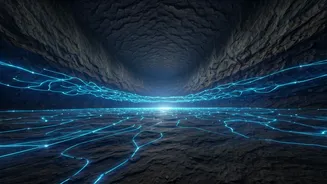Quarks' Subtle Movements
The exploration of quarks, the fundamental constituents of protons, has entered a new era thanks to a novel theoretical approach. For a long time, scientists
have been trying to understand the nature of quark motion within protons. The focus has often been on their momentum in the direction of travel, but the transverse, or side-to-side, motion has been more difficult to study. This transverse motion is where the new theory makes a difference. This motion is not very pronounced, but its effects are significant in understanding the properties of protons, and in explaining their interactions. The new theory allows scientists to observe the detailed behavior of quarks, providing a deeper understanding of how these particles interact and contribute to the overall structure of matter. This approach brings new opportunities to study the fundamental particles.
Lattice QCD Calculations
The groundbreaking calculations at the heart of this advancement rely on Lattice Quantum Chromodynamics (Lattice QCD). Lattice QCD is a computational approach that allows physicists to model the behavior of quarks and gluons, the particles that mediate the strong force, on a discrete spacetime lattice. By using this technique, researchers can perform complex simulations that would be impossible with traditional methods. These simulations consider the interactions of quarks as they move within the proton. The team’s innovative approach unlocks the capacity to quantify the minute transverse motions of quarks, which opens a new pathway into the deep dynamics of protons. The new calculations add a sophisticated layer to our understanding of how quarks move, interact, and ultimately, build the protons themselves. It's an important tool for investigating the complexities of the strong force that binds quarks together.
Unveiling Physics Mysteries
This novel method presents a unique opportunity to address many unresolved questions in the field of physics. One particular area of investigation is the distribution of quarks within protons and how this distribution influences proton properties, such as their spin. Studying the transverse motion is essential to this task, as it provides a detailed picture of quark behavior. This research may reveal how protons form and decay, how they interact with each other, and how they contribute to the properties of atomic nuclei. By measuring the transverse motion of quarks, scientists can refine existing models and test the consistency of the Standard Model of particle physics. This exploration has the potential to lead to a more complete and precise understanding of the fundamental structure of matter and the forces that govern it. Therefore, this breakthrough is critical in the quest to comprehend the universe’s most basic components.
Future Research Pathways
The recent findings open exciting avenues for future research in particle physics. Scientists are now in a position to refine their models of quark behavior and investigate the effects of different factors, such as the quark's momentum and the presence of other particles. Future research could focus on investigating the role of gluons, the force-carrying particles that mediate the strong force, in the transverse motion of quarks. Researchers can explore the properties of other particles, as well. These investigations could yield insights into the complex dynamics of protons and other subatomic particles, ultimately contributing to a richer understanding of how matter is constructed. The combination of experimental data and theoretical calculations will further refine our understanding of quark dynamics, advancing our knowledge of the universe’s fundamental components and their interactions.










